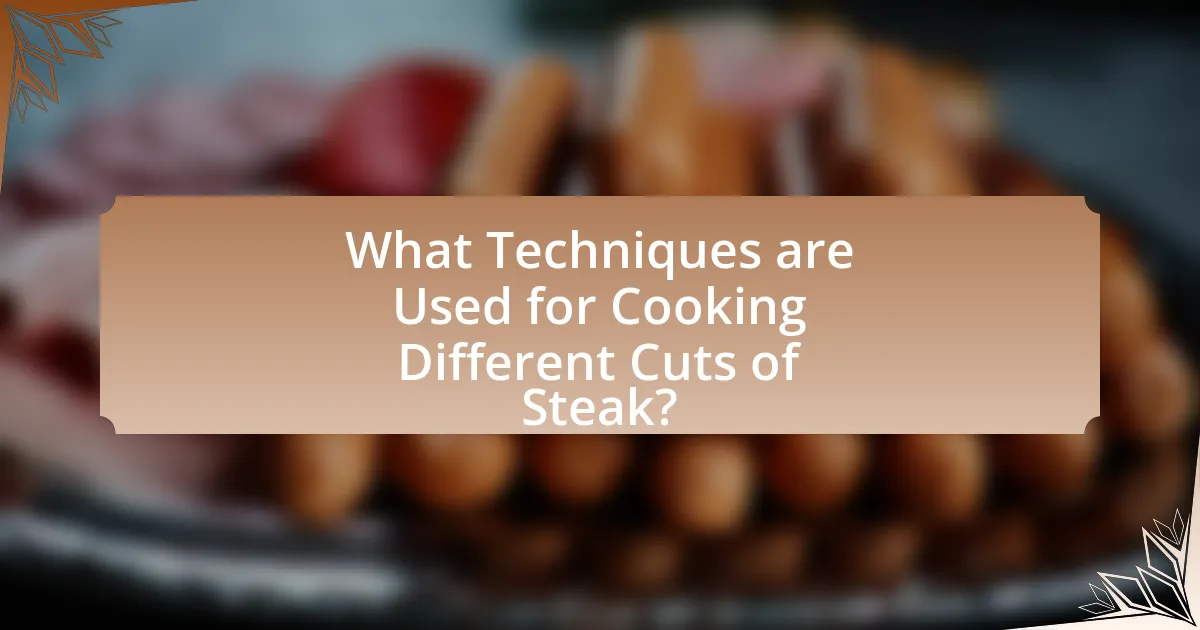The article focuses on the various cuts of steak, including ribeye, sirloin, tenderloin, T-bone, porterhouse, flank, and skirt steak, highlighting their differences in tenderness, flavor, and cooking methods. It categorizes steak cuts into primal, sub-primal, and retail cuts, explaining how the location of each cut on the cow affects its characteristics. The article also discusses the best cooking techniques for different cuts, recommended temperatures for doneness, and tips for enhancing the cooking experience, including seasoning and avoiding common mistakes. Additionally, it emphasizes the importance of understanding each cut’s unique qualities to achieve optimal flavor and texture in steak preparation.

What are the Different Cuts of Steak?
The different cuts of steak include ribeye, sirloin, tenderloin, T-bone, porterhouse, flank, and skirt steak. Each cut varies in tenderness, flavor, and cooking methods. For example, ribeye is known for its marbling and rich flavor, making it ideal for grilling, while tenderloin is the most tender cut, often used for filet mignon. T-bone and porterhouse steaks contain both tenderloin and strip steak, offering a combination of textures. Flank and skirt steaks are leaner cuts, best suited for marinating and quick cooking methods like grilling or stir-frying. These distinctions are based on the location of the cut on the cow and the muscle’s usage, which affects tenderness and flavor.
How are steak cuts categorized?
Steak cuts are categorized primarily based on the location of the cut on the animal, which influences tenderness, flavor, and cooking methods. The main categories include primal cuts, which are large sections of the animal, and sub-primal cuts, which are smaller portions derived from the primal cuts. For example, the rib primal includes cuts like ribeye and prime rib, while the loin primal includes tender cuts such as filet mignon and T-bone. This classification is essential for understanding the characteristics and best cooking techniques for each cut, as different cuts require different preparation methods to achieve optimal flavor and texture.
What are the primary categories of steak cuts?
The primary categories of steak cuts are typically classified into three main groups: primal cuts, subprimal cuts, and retail cuts. Primal cuts refer to the large sections of beef that are initially separated from the carcass, such as the chuck, rib, loin, and round. Subprimal cuts are derived from these primal cuts and include specific sections like ribeye and tenderloin. Retail cuts are the final products sold to consumers, which can include steaks like sirloin, flank, and T-bone. This classification is widely recognized in the meat industry and helps consumers understand the origin and quality of different steak options.
How does the location of the cut affect its characteristics?
The location of the cut significantly affects the characteristics of the steak, including tenderness, flavor, and fat content. Cuts from the loin and rib sections, such as ribeye and tenderloin, are generally more tender due to less muscle usage, resulting in a softer texture. In contrast, cuts from the shoulder or leg, like chuck or round, contain more connective tissue and are typically tougher, requiring longer cooking methods to become palatable. Additionally, the fat distribution varies by location; for instance, rib cuts have more marbling, enhancing flavor, while leaner cuts from the round are less flavorful but lower in fat. This relationship between cut location and steak characteristics is well-documented in culinary studies, emphasizing the importance of understanding anatomy for optimal cooking techniques.
What are the most popular cuts of steak?
The most popular cuts of steak include ribeye, sirloin, filet mignon, T-bone, and New York strip. Ribeye is favored for its marbling and flavor, making it a top choice among steak enthusiasts. Sirloin is known for its balance of tenderness and flavor, while filet mignon is prized for its buttery texture. T-bone combines the best of both worlds with a portion of tenderloin and strip steak, and New York strip is celebrated for its robust flavor and tenderness. These cuts are commonly featured in restaurants and are often recommended by chefs for their distinct qualities and cooking versatility.
What distinguishes ribeye from sirloin?
Ribeye is distinguished from sirloin primarily by its marbling and tenderness. Ribeye contains a higher fat content, specifically intramuscular fat, which contributes to its rich flavor and juiciness, making it more tender compared to sirloin. Sirloin, while still flavorful, has less fat and is generally leaner, resulting in a firmer texture. The ribeye cut comes from the rib section of the cow, while sirloin is taken from the rear back portion. This anatomical difference influences their respective textures and flavors, with ribeye being favored for its succulence and sirloin being appreciated for its leaner profile.
Why is filet mignon considered a premium cut?
Filet mignon is considered a premium cut due to its tenderness and flavor profile. This cut comes from the tenderloin, a muscle that does not bear weight, resulting in a soft texture. Additionally, filet mignon has a lower fat content compared to other cuts, which enhances its delicate taste. The combination of these characteristics makes it highly sought after in fine dining and often commands a higher price.

What Techniques are Used for Cooking Different Cuts of Steak?
Different cuts of steak are cooked using techniques that suit their texture and fat content. For tender cuts like filet mignon, grilling or pan-searing at high heat is effective, as these methods enhance flavor while preserving tenderness. Conversely, tougher cuts such as flank or skirt steak benefit from marinating and cooking methods like braising or slow-cooking, which break down connective tissues and improve tenderness.
For example, the USDA recommends grilling ribeye steaks to achieve a juicy, flavorful result due to their marbling, while chuck steaks are best suited for slow-cooking to tenderize the meat. These techniques are validated by culinary practices that emphasize the importance of matching cooking methods to the specific characteristics of each steak cut.
How does cooking method vary by steak cut?
Cooking methods vary significantly by steak cut due to differences in tenderness, fat content, and muscle structure. For example, tender cuts like filet mignon are best suited for quick cooking methods such as grilling or pan-searing, which preserve their juiciness and flavor. In contrast, tougher cuts like chuck or brisket benefit from slow cooking methods such as braising or smoking, which break down connective tissues and enhance tenderness. The USDA categorizes steak cuts based on these characteristics, indicating that cuts from the loin and rib sections are typically more tender and suitable for high-heat cooking, while cuts from the round and chuck sections require longer cooking times to achieve optimal texture.
What are the best cooking methods for tender cuts?
The best cooking methods for tender cuts include grilling, pan-searing, and roasting. These methods enhance the natural tenderness and flavor of cuts such as filet mignon, ribeye, and sirloin. Grilling allows for high heat that creates a flavorful crust while keeping the inside juicy. Pan-searing provides a similar effect, with the added benefit of allowing for the incorporation of sauces. Roasting, particularly at moderate temperatures, ensures even cooking and retains moisture. These techniques are widely recognized in culinary practices for maximizing the quality of tender cuts.
How should tougher cuts be prepared for optimal flavor?
Tougher cuts of steak should be prepared using methods that involve slow cooking or marinating to enhance their flavor and tenderness. Techniques such as braising, slow roasting, or using a pressure cooker break down the connective tissues in these cuts, making them more palatable. For instance, marinating tougher cuts in acidic ingredients like vinegar or citrus juices for several hours can help tenderize the meat while infusing it with flavor. Additionally, cooking at low temperatures for extended periods allows the collagen in the meat to dissolve, resulting in a more flavorful and tender dish.
What are the recommended temperatures for cooking steak?
The recommended temperatures for cooking steak vary based on the desired doneness. For rare steak, the internal temperature should reach 125°F (52°C); for medium-rare, it should be 135°F (57°C); for medium, the target is 145°F (63°C); for medium-well, aim for 150°F (66°C); and for well-done, the temperature should be 160°F (71°C) or higher. These temperatures ensure that the steak is cooked to the preferred level of doneness while maintaining its flavor and juiciness.
How do you determine the perfect doneness for each cut?
To determine the perfect doneness for each cut of steak, use a combination of internal temperature measurements and visual cues. Each cut has a specific temperature range that corresponds to its ideal doneness: rare (120-125°F), medium rare (130-135°F), medium (140-145°F), medium well (150-155°F), and well done (160°F and above). For example, a ribeye steak is best enjoyed at medium rare, while a filet mignon can also be served at medium rare for optimal tenderness. Using a meat thermometer provides an accurate reading, ensuring that the steak reaches the desired doneness without overcooking. Additionally, observing the color and firmness of the meat can serve as a secondary indicator; for instance, a rare steak will be soft and red in the center, while a well-done steak will be firm and brown throughout.
What tools can help achieve the desired cooking temperature?
Thermometers, such as instant-read and probe thermometers, are essential tools for achieving the desired cooking temperature. Instant-read thermometers provide quick temperature readings, allowing cooks to check doneness accurately, while probe thermometers can be left in the meat during cooking to monitor temperature continuously. According to the USDA, cooking meat to the correct internal temperature is crucial for food safety, with specific temperatures recommended for different cuts of steak. For example, a medium-rare steak should reach an internal temperature of 135°F (57°C). Using these thermometers ensures that steaks are cooked to the preferred doneness while maintaining safety standards.

What Tips Can Enhance Your Steak Cooking Experience?
To enhance your steak cooking experience, start by selecting the right cut of steak, as different cuts require different cooking techniques. For example, tender cuts like filet mignon benefit from quick, high-heat cooking methods such as grilling or pan-searing, while tougher cuts like flank steak are best suited for marinating and slow cooking to break down the fibers. Additionally, allowing the steak to rest after cooking is crucial; resting for about 5 to 10 minutes helps redistribute the juices, resulting in a more flavorful and moist steak. Using a meat thermometer to check for doneness ensures that the steak is cooked to your preferred level, with 130°F for medium-rare being a widely accepted standard. These tips are supported by culinary experts who emphasize the importance of cut selection, resting, and precise cooking temperatures for optimal steak preparation.
How can seasoning impact the flavor of steak?
Seasoning significantly enhances the flavor of steak by adding depth and complexity to its natural taste. When salt is applied, it not only enhances the meat’s inherent flavors but also helps to tenderize the steak by breaking down proteins. Additionally, herbs and spices contribute unique flavor profiles; for example, garlic powder adds a savory note, while black pepper introduces heat. According to a study published in the Journal of Food Science, the Maillard reaction, which occurs during cooking, is intensified by seasoning, resulting in a more flavorful crust. This interaction between seasoning and cooking techniques is crucial for achieving a well-balanced and delicious steak.
What are the best seasoning techniques for different cuts?
The best seasoning techniques for different cuts of steak include dry brining, marinating, and using rubs. Dry brining, which involves salting the steak and allowing it to rest, enhances flavor and tenderness, particularly effective for thicker cuts like ribeye and porterhouse. Marinating, which involves soaking the steak in a mixture of acids, oils, and spices, is ideal for tougher cuts such as flank or skirt steak, as it helps to break down fibers and infuse flavor. Using dry rubs, a blend of spices and herbs, works well for cuts like sirloin and T-bone, providing a flavorful crust when seared. These techniques are supported by culinary practices that emphasize the importance of seasoning in enhancing the natural flavors of the meat.
How does marinating affect the tenderness of steak?
Marinating significantly enhances the tenderness of steak by breaking down muscle fibers and connective tissues. The acidic components in marinades, such as vinegar or citrus juice, denature proteins, making them more tender. Additionally, enzymes found in ingredients like pineapple or papaya further aid in this process by digesting proteins. Research indicates that marinating for at least 30 minutes can yield noticeable improvements in tenderness, with longer marination times often resulting in even more pronounced effects.
What common mistakes should be avoided when cooking steak?
Common mistakes to avoid when cooking steak include not allowing the steak to come to room temperature before cooking, which can lead to uneven cooking. Additionally, using a low cooking temperature can result in a tough texture, as high heat is necessary to achieve a proper sear and caramelization. Overcrowding the pan can also cause steaming instead of searing, preventing the desired crust from forming. Finally, cutting into the steak immediately after cooking can cause juices to escape, leading to a dry result; resting the steak for a few minutes allows the juices to redistribute.
How can overcooking be prevented?
To prevent overcooking, monitor the cooking time and temperature closely. Using a meat thermometer to check the internal temperature of the steak ensures it reaches the desired doneness without exceeding it. For example, a medium-rare steak should be cooked to an internal temperature of 130-135°F (54-57°C). Additionally, removing the steak from heat a few degrees before it reaches the target temperature allows for carryover cooking, where the steak continues to cook slightly after being removed from the heat source. This method effectively reduces the risk of overcooking and maintains the steak’s juiciness and flavor.
What are the signs of a well-cooked steak?
A well-cooked steak exhibits a few key signs: it has a consistent internal temperature, a desirable level of juiciness, and a pleasing crust. The internal temperature should align with the desired doneness, such as 130-135°F for medium-rare. Juiciness is indicated by the steak’s ability to retain moisture, which can be assessed by cutting into it and observing the release of juices. A pleasing crust, characterized by a brown, caramelized exterior, results from proper searing and contributes to flavor. These indicators confirm that the steak has been cooked correctly, enhancing both texture and taste.










